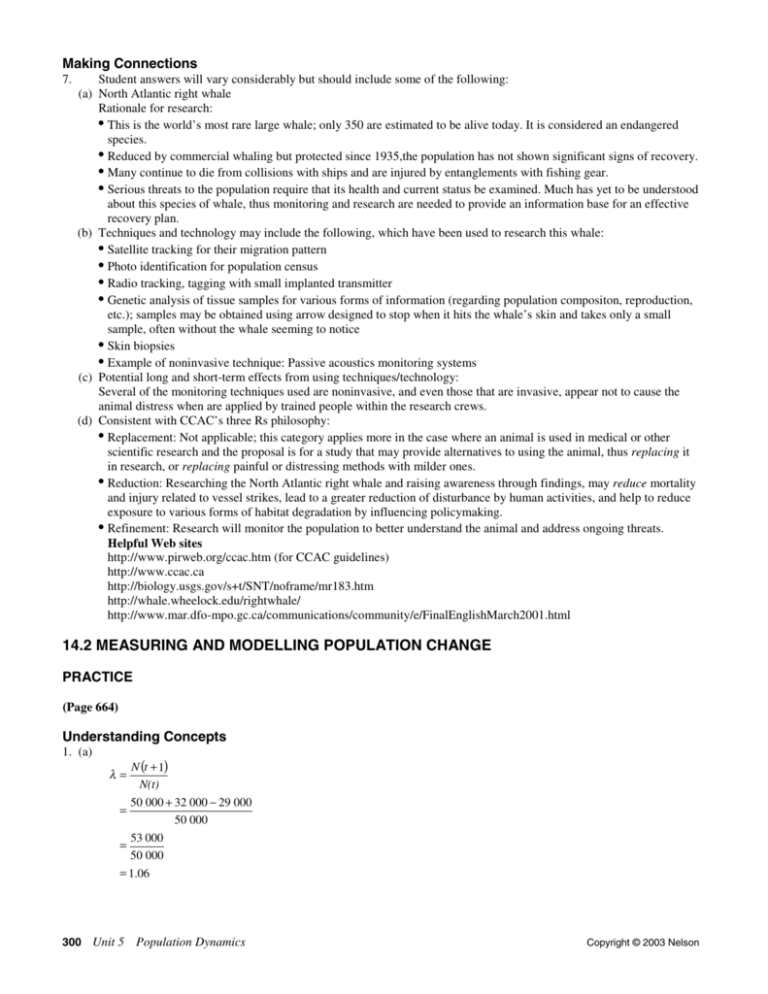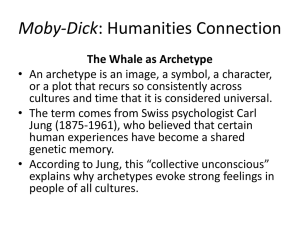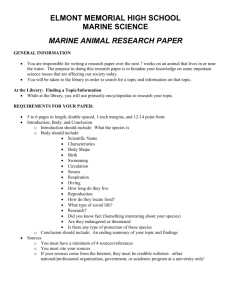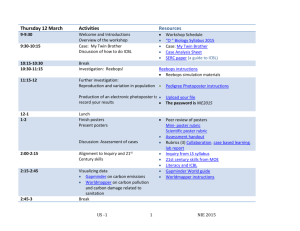14.2 Solutions
advertisement

Making Connections 7. Student answers will vary considerably but should include some of the following: (a) North Atlantic right whale Rationale for research: • This is the world’s most rare large whale; only 350 are estimated to be alive today. It is considered an endangered species. • Reduced by commercial whaling but protected since 1935,the population has not shown significant signs of recovery. • Many continue to die from collisions with ships and are injured by entanglements with fishing gear. • Serious threats to the population require that its health and current status be examined. Much has yet to be understood about this species of whale, thus monitoring and research are needed to provide an information base for an effective recovery plan. (b) Techniques and technology may include the following, which have been used to research this whale: • Satellite tracking for their migration pattern • Photo identification for population census • Radio tracking, tagging with small implanted transmitter • Genetic analysis of tissue samples for various forms of information (regarding population compositon, reproduction, etc.); samples may be obtained using arrow designed to stop when it hits the whale’s skin and takes only a small sample, often without the whale seeming to notice • Skin biopsies • Example of noninvasive technique: Passive acoustics monitoring systems (c) Potential long and short-term effects from using techniques/technology: Several of the monitoring techniques used are noninvasive, and even those that are invasive, appear not to cause the animal distress when are applied by trained people within the research crews. (d) Consistent with CCAC’s three Rs philosophy: • Replacement: Not applicable; this category applies more in the case where an animal is used in medical or other scientific research and the proposal is for a study that may provide alternatives to using the animal, thus replacing it in research, or replacing painful or distressing methods with milder ones. • Reduction: Researching the North Atlantic right whale and raising awareness through findings, may reduce mortality and injury related to vessel strikes, lead to a greater reduction of disturbance by human activities, and help to reduce exposure to various forms of habitat degradation by influencing policymaking. • Refinement: Research will monitor the population to better understand the animal and address ongoing threats. Helpful Web sites http://www.pirweb.org/ccac.htm (for CCAC guidelines) http://www.ccac.ca http://biology.usgs.gov/s+t/SNT/noframe/mr183.htm http://whale.wheelock.edu/rightwhale/ http://www.mar.dfo-mpo.gc.ca/communications/community/e/FinalEnglishMarch2001.html 14.2 MEASURING AND MODELLING POPULATION CHANGE PRACTICE (Page 664) Understanding Concepts 1. (a) N (t + 1) N(t) 50 000 + 32 000 − 29 000 = 50 000 λ= = 53 000 50 000 = 1.06 300 Unit 5 Population Dynamics Copyright © 2003 Nelson (b) N (2) = N (0) t N (2) = (50 000)(1.06)2 N (2) = 56 180 N (10) = N (0) t N (10) = (50 000)(1.06)10 N (10) = 89 540 PRACTICE (Page 665) Understanding Concepts 2. (a) dN = rN dt dN = (0.345 / day)980 dt dN = 338 / day dt (b) 0.69 r 0.69 = 0.345 / day = 2 days td = (c) final population initial population 2 000 000 2 td = 980 = 2040 2 td = 2 td =2040, so td = 11 and each td = 2 days, so 22 days are needed. PRACTICE (Page 668) Understanding Concepts 3. r-max Population size (N) 1.00 20 1.00 200 Copyright © 2003 Nelson (K − N ) ] K 1000 − 20 1000 1000 − 200 1000 [ Population growth rate 19.6 160 Chapter 14 Population Ecology 301 4. 1.00 500 1.00 900 1.00 990 1.00 1000 1000 − 500 1000 1000 − 900 1000 1000 − 990 1000 1000 − 1000 1000 250 90 9.9 0 No. Carrying capacity is determined mostly by the amount of food that is present. As the population approaches the carrying capacity, the growth rate should decrease. Otherwise, the population will exceed carrying capacity, food resources will be depleted, and organisms will starve. Section 14.2 Questions (Pages 669–670) Understanding Concepts 1. population increase = 20 + 4 = 24 population decrease = 9 + 11 + 8 = 28 N (t + 1) λ= N (t ) (24 − 28) + 34 = 34 = 0.88 2. (b + i) − ( d + e) n (342 + i) − ( 43 + 0) 429 = 90 i = 87 population change = 3. N (t + 1) N (t ) 42 + 263 − 26 − 8 − 12 = 42 = 6. 2 λ= 4. (a) exponential (b) N(t) = N(0) λ t N(t) = (2)4.58 = 336 000 ( assuming that the species mature in one year) 5. (a) Exponential (b) Large food supply, enough space to minimize disease spread by overcrowding, little predation, especially by man. (c) Decreasing food supply leads to starvation, increasing disease; overcrowding leading to increased competition for resources. 6. Student answers will vary. Some possible reasons include the following: • lack of new surfaces for attachment • exhaustion of food resources • spread of disease in crowded habitat • introduction of predators 302 Unit 5 Population Dynamics Copyright © 2003 Nelson Applying Inquiry Skills 7. (a) population change = (34 + 12) – (86 + 0) = N(t+1) = 198 = 158 í N (t + 1) N 158 = 198 = 0.8 í λ= í The population has a growth rate of (b) The population decrease represents about 25% of the population. This is a considerable change in a small population. Because frogs are an indicator species, one would be concerned about the quality of the environment that the frogs are in. A study of any changes in the marsh itself would be needed, such as water temperature, depth, quality, and cold periods during egg laying or tadpole growth periods. (c) This study is not adequate to make conclusions about the environment. Too many accidental factors can affect small, isolated populations like this one. Larger studies over larger areas and longer periods are needed to show the impact of environmental factors. 8. (a) N (t + 1) N (t ) 8 λ= 2 λ=4 N (t ) = N (0)λt λ= N (5) = 2(4) 5 N (5) = 2048 (b) N(t) = N(0) λ t 2 8 32 128 512 2048 generation 0 1 2 3 4 5 snake population 2500 2000 1500 population 1000 500 0 0 1 2 3 4 5 generation Copyright © 2003 Nelson Chapter 14 Population Ecology 303 (c) The population growth would still be exponential, although not at as fast as with a growth rate of six offspring per pair per year. As the chart below shows, the growth rate is still exponential and the curve will be identical to the one above, although the numbers along the y-axis will be lower. generation 0 1 2 3 4 5 N(t) =N(0) λ t 2 5 13 31 78 195 Making Connections 9. (a) Student answers will vary considerably but should include some of the following: Potential action plans: (i) Reactive control methods (i.e. to control already established population). These may include mechanical cleaning; desiccation; thermal treatment; high-pressure water jetting; scraping; oxygen deprivation; freezing; or chemical treatment (ii) Acoustic energy (AE) has been shown to be very effective in preventing attachment of juvenile mussels to pipes; a range of 3 kHz to 8 kHz, with acceleration of about 150 m/sec2 to 200 m/sec2 have yielded 75% to 100% mussel detachment and mortality. These are within limits that allow for normal operation of piping equipment and are especially promising, because the technique does not require the use of chemicals and is financially feasible. (iii) Extremely low frequency electromagnetism (ELF EM); it is similar to AE (above), does not require chemical use, can be installed in water intake systems, and is a low-maintenance form of control. (iv) Low pressure; it can be used where flow is of raw, untreated water. Vacuum pressure in pipe segments will decrease the O2 supply in water to near 0, suffocating the mussels, which can then be removed by back flushing (the process takes about 2 to 3 days per section). (v) Raising public awareness and sense of individual responsibility: teach boaters the importance of examining and how to examine their vessels for zebra mussels, and how to prevent infestation. (b) Student PMI charts will vary. A summary of PMI charts and what they should include is found in Appendix A4 of the Student Text, page 768. 14.3 FACTORS AFFECTING POPULATION CHANGE Section 14.3 Questions (Page 675) Understanding Concepts 1. Natality is the number of births in the population and therefore increases population size. This increases population density, which in turn can increase intraspecific competition. Mortality is the number of deaths in the population and therefore decreases population size. This decreases population size. Immigration is the number of individuals that enter the population. Like natality, this can increase population density and can therefore increase intraspecific competition. Emigration is the number of individuals that leave the population. This is like death, which decreases population size. 2. Density-dependent factors are those that influence population regulation, having a greater impact as population density increases or decreases. Density-independent factors are those that influence population regulation regardless of population density. 3. (a) density dependent (b) density independent (c) density independent 4. Density independent: rainfall will affect plant growth, which affects herbivore populations as well. Density dependent: fire spreads quickly through dense vegetation, especially if the vegetation is the same age and height. Applying Inquiry Skills 5. (a) density dependent 304 Unit 5 Population Dynamics Copyright © 2003 Nelson

![Blue and fin whale populations [MM 2.4.1] Ecologists use the](http://s3.studylib.net/store/data/008646945_1-b8cb28bdd3491236d14c964cfafa113a-300x300.png)






